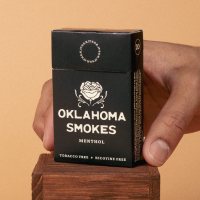At some point in our life, we step back and evaluate our habits to determine what we can do better. With the goal of living a healthier life, the idea of stepping away from habits such as alcohol, marijuana, or drug use is encouraging.
With these habits come the effects of addiction, both the chemical addiction and the repetitive patterns like oral fixation that make quittin’ cold turkey more difficult. To reach the goal of getting away from these habits, consider switching to alternatives to help wean you off.
Alternatives allow you to step away from the chemical interactions that come with marijuana addiction and handle cannabis withdrawal more effectively while maintaining your rituals and routines. This can be seen with cigarette smokers switching to non-tobacco cigarettes, so they can pull themselves away from nicotine while maintaining the physical habit of smoking, making the process of quitting much easier.
Of course, once your body detoxes and is pulled away from the chemical dependency, you’re then supposed to work on changing your habits.
While it’s easy to find alternatives to cigarettes or alcohol, are there alternatives to weed for marijuana users?
These effective alternatives will help you stop smoking weed and pull yourself away from the harmful effects of Tetrahydrocannabinol (THC), which we will talk more about below.
Why is Weed Addictive?
Whenever attempting to pull away from an addictive substance, you should gain a deeper understanding of what you’re addicted to and how it’s affecting you.
Similar to other addictive substances, weed use can make you “feel good,” which your body enjoys and craves. Some people even use it to self-medicate and cope with different physical and mental health problems.
Why shouldn’t you be more relaxed or have less muscle tension? Addiction refers to the need to have something, even without reason, leading to repetitive substance use.
Weed, also known as bud, marijuana, cannabis, and many other names, is best described as the cannabis plant grown for psychoactive effects. The substance creating these psychoactive effects is Tetrahydrocannabinol, known as THC.
THC is the psychoactive element found in weed, which is often the source of addiction. THC can affect your body in 2 primary manners, depending on the plant's strain.
Another substance responsible, not for intoxication but rather for physical soothing and easing discomfort without the high, also comes from the cannabis plant -- cannabidiol, known as CBD.
CBD is responsible for many of the positive physical effects associated with weed, and since the 2018 reform, has become widely used as an all-natural wellness supplement. CBD promotes health benefits such as easing discomfort, soothing tension, relaxing the mind, and more
THC is the psychoactive element found in weed, which is often the source of addiction. THC can affect your body in 2 primary manners, depending on the plant's strain.
Weed Alternatives

While considering what the body is craving, the best alternatives for THC involve improved overall health. Smoking pot can give you energy, allow you to destress, and reduce pain, which are all benefits of living a healthier lifestyle.
These alternatives could also help you deal with marijuana withdrawal more effectively and comfortably.
Hemp
Hemp is a form of cannabis sativa. However, by law, it must have below 0.3% THC, which results in no psychoactive effects. hemp cigarettes, vape juices, oils, and raw ground hemp are sources of beneficial cannabinoids without the THC. They are the more literal alternative to marijuana, or even cigarettes, that still allow you to smoke.
Smoking hemp flower as a marijuana alternative allows you to receive the taste and smell you're used to with weed. It also provides the ability to use hemp in all the same manners as weed, without the psychoactive and potentially addictive elements. By eliminating the chemical dependency, you’re able to focus on separating yourself from the addictive effects of marijuana.
CBD
While CBD is a product of marijuana, and is often consumed when smoking weed, CBD and THC act separately within the body. While THC creates a psychoactive effect, CBD can soothe the body and deliver a range of other wellness benefits.
Some strains of hemp can be grown to be packed full of CBD, so smoking hemp flower can give you a nice hit of CBD. You can also use CBD extract directly through a wide variety of products such as vapes, tinctures, lotions, capsules, etc.
Many of the relaxing and stress-relieving feelings associated with weed are thanks to CBD. These include the physical feeling of being soothed but without the intoxicating high.
Herbal Cigarettes

While similar to CBD cigarettes, herbal cigarettes are shaped like and can be smoked similar to an actual cigarette.
Instead of tobacco or weed, herbal cigarettes are packed with:
- Passion flower
- Corn silk
- Rose petals
- Lotus leaf
- Licorice root
- Jasmine
- Ginseng
- Red clover flowers
These allow you to kick back and light up without the chemical dependencies or potentially addictive substances. Each herb is packed with unique flavors and scents that you may find you really enjoy and may even recognize from teas or dishes you already consume.
Exercising in the Great Outdoors
When you’re smoking marijuana, your body releases a chemical known as dopamine, which is responsible for the interaction between your brain’s different neurons. This communication is what tells your body to pay attention, be happy, or even feel pleasure. This is why you “feel good” when you smoke weed.
A natural way to release dopamine is to become active.
With just 10 to 20 minutes a day, being more active by walking, running, or working out can naturally raise the dopamine levels in your body. Exercise can also release endorphins, which are basically pain-relieving hormones that also work to help your body “feel good.”
While you could simply hit the gym, sunlight exposure is also known to spike dopamine levels.
Adding more to the benefits of being outdoors in nature, becoming more relaxed can increase your overall health and dopamine levels, too. Getting outside and into nature increases your natural dopamine by all three methods above.
When searching for a park, you may need to use terms such as:
- Parks (National, State, Cities)
- Nature Preserves
- Metro Parks
- Trails
- Walkways
- Forests
- Lookouts
Tips For Effective Quitting
So you’ve decided you would like to quit smoking weed. When looking at substance abuse and addictions, simply walking away cold turkey can be a rough approach. Your body will begin craving the dopamine release and may begin affecting you mentally and physically. Here are some tips to help combat the cravings and kickstart your addiction treatment:
1.Tell the people around you the plan to quit. This will reduce people asking you if you want to smoke, and lets them know why you may have mood swings over the next couple weeks.
2. Set realistic goals for yourself. While quitting is the end goal, mini checkpoints are a great way to encourage and visualize your improvement. Examples of these goals could be cutting back on how much you smoke each day, then cutting back to once a day and replacing the cravings with alternatives. Then switch to only using alternatives. It’s also a good idea to throw out any weed paraphernalia you may have, such as pipes and bongs.
3. Find alternatives that help you overcome withdrawals. This is where products like hemp cigarettes truly shine, satisfying that need for the physical experience of smoking, while pulling you away from chemical dependency.
4. Change your lifestyle. Get out and do more of what you enjoy and makes you happy. You being happy releases dopamine, and getting back into a hobby can keep your mind and hands busy.
5. Try new things. You’ll never know if you enjoy things outside of your norm if you don’t try them. Go walk a trail, kayak, or explore a big city.
Summary

While pulling away from any chemical marijuana dependence will be difficult, turning to alternatives to THC can help reduce the cravings and withdrawals when pulling away from cannabis use.
Treatment options like hemp cigarettes allow you to reduce your intake of THC, while still being able to satisfy your physical craving for smoking cannabis. Lifestyle changes such as doing more physical activities and picking up a hobby can help you put your mind to somewhere positive while releasing healthy levels of natural dopamine.
You can find knowledge and support along your path to a healthier life with Oklahoma Smokes, through our hemp alternatives and resources for quitting.
With THC and tobacco alternatives, your healthier lifestyle starts here!
Sources
Find a Park | National Park Service
WTF Does CBD Have To Do With THC? | Emjay
FAQs on How to Quit Smoking Weed
1. Can I get treatment for weed addiction?
Yes. If you or a loved one is addicted, it’s best to get professional help and undergo a treatment program for marijuana use disorder. According to the National Institutes of Health (NIH), it is a common condition in the US but is largely left untreated.
2. What are the side effects of smoking weed?
Experiencing withdrawal is not fun. Some symptoms and negative effects of marijuana withdrawal include:
- Mood changes
- Decreased appetite
- Trouble sleeping
- Headaches
- Weed cravings
- Chills and cold sweats
3. Why should I quit smoking weed?
Although not as heavily addictive as other substances, one could still develop an addiction to weed. Heavy cannabis use could affect one’s brain function, heart health, bone health, and lung health, especially if one starts using it at a young age.






